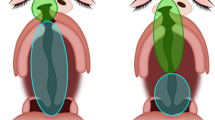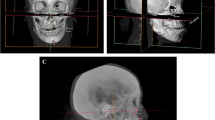Abstract
Objectives
To determine the relationship between nasolabial symmetry and esthetics in subjects with orofacial clefts.
Material and methods
Eighty-four subjects (mean age 10 years, standard deviation 1.5) with various types of nonsyndromic clefts were included: 11 had unilateral cleft lip (UCL); 30 had unilateral cleft lip and alveolus (UCLA); and 43 had unilateral cleft lip, alveolus, and palate (UCLAP). A 3D stereophotogrammetric image of the face was taken for each subject. Symmetry and esthetics were evaluated on cropped 3D facial images. The degree of asymmetry of the nasolabial area was calculated based on all 3D data points using a surface registration algorithm. Esthetic ratings of various elements of nasal morphology were performed by eight lay raters on a 100 mm visual analog scale. Statistical analysis included ANOVA tests and regression models.
Results
Nasolabial asymmetry increased with growing severity of the cleft (p = 0.029). Overall, nasolabial appearance was affected by nasolabial asymmetry; subjects with more nasolabial asymmetry were judged as having a less esthetically pleasing nasolabial area (p < 0.001). However, the relationship between nasolabial symmetry and esthetics was relatively weak in subjects with UCLAP, in whom only vermilion border esthetics was associated with asymmetry.
Conclusions
Nasolabial symmetry assessed with 3D facial imaging can be used as an objective measure of treatment outcome in subjects with less severe cleft deformity. In subjects with more severe cleft types, other factors may play a decisive role.
Clinical significance
Assessment of nasolabial symmetry is a useful measure of treatment success in less severe cleft types.



Similar content being viewed by others
References
Aharon I, Etcoff N, Ariely D, Chabris CF, O’Connor E et al (2001) Beautiful faces have variable reward value: fMRI and behavioral evidence. Neuron 32:537–551
O’Doherty J, Winston J, Critchley H, Perrett D, Burt DM et al (2003) Beauty in a smile: the role of medial orbitofrontal cortex in facial attractiveness. Neuropsychologia 41:147–155
Dion K, Walster E, Berschei E (1972) What is beautiful is good. J Pers Soc Psychol 24:285
Langlois JH, Kalakanis L, Rubenstein AJ, Larson A, Hallam M et al (2000) Maxims or myths of beauty? A meta-analytic and theoretical review. Psychol Bull 126:390–423
Eagly AH, Makhijani MG, Ashmore RD, Longo LC (1991) What is beautiful is good, but—a meta-analytic review of research on the physical attractiveness stereotype. Psychol Bull 110:109–128
Benson PL, Karabenick SA, Lerner RM (1976) Pretty pleases—effects of physical attractiveness, race, and sex on receiving help. J Exp Soc Psychol 12:409–415
Ritts V, Patterson ML, Tubbs ME (1992) Expectations, impressions, and judgments of physically attractive students—a review. Rev Educ Res 62:413–426
Rhodes G (2006) The evolutionary psychology of facial beauty. Annu Rev Psychol 57:199–226
Cunningham MR, Roberts AR, Wu CH, Barbee AP, Druen PB (1995) Their ideas of beauty are, on the whole, the same as ours—consistency and variability in the cross-cultural perception of female physical attractiveness. J Pers Soc Psychol 68:261–279
Perrett DI, May KA, Yoshikawa S (1994) Facial shape and judgments of female attractiveness. Nature 368:239–242
Rhodes G, Yoshikawa S, Clark A, Lee K, McKay R et al (2001) Attractiveness of facial averageness and symmetry in non-Western cultures: in search of biologically based standards of beauty. Perception 30:611–625
Geldart S, Maurer D, Carney K (1999) Effects of eye size on adults’ aesthetic ratings of faces and 5-month-olds’ looking times. Perception 28:361–374
Langlois JH, Roggman LA, Casey RJ, Ritter JM, Rieserdanner LA et al (1987) Infant preferences for attractive faces—rudiments of a stereotype. Dev Psychol 23:363–369
Rubenstein AJ, Kalakanis L, Langlois JH (1999) Infant preferences for attractive faces: a cognitive explanation. Dev Psychol 35:848–855
Samuels CA, Butterworth G, Roberts T, Graupner L, Hole G (1994) Facial aesthetics—babies prefer attractiveness to symmetry. Perception 23:823–831
Samuels CA, Ewy R (1985) Aesthetic perception of faces during infancy. Br J Dev Psychol 3:221–228
Slater A, Quinn PC, Hayes R, Brown E (2000) The role of facial orientation in newborn infants’ preference for attractive faces. Dev Sci 3:181–185
Enquist M, Arak A (1994) Symmetry, beauty and evolution. Nature 372:169–172
Jansson L, Forkman B, Enquist M (2002) Experimental evidence of receiver bias for symmetry. Anim Behav 63:617–621
Johnstone RA (1994) Female preference for symmetrical males as a by-product of selection for mate recognition. Nature 372:172–175
Perrett DI, Burt DM, Penton-Voak IS, Lee KJ, Rowland DA et al (1999) Symmetry and human facial attractiveness. Evol Hum Behav 20:295–307
Rhodes G, Sumich A, Byatt G (1999) Are average facial configurations attractive only because of their symmetry? Psychol Sci 10:52–58
Russell KA, Waldman SD, Tompson B, Lee JM (2001) Nasal morphology and shape parameters as predictors of nasal esthetics in individuals with complete unilateral cleft lip and palate. Cleft Palate Craniofac J J38:476–485
Fudalej P, Katsaros C, Hozyasz K, Borstlap WA, Kuijpers-Jagtman AM (2012) Nasolabial symmetry and aesthetics in children with complete unilateral cleft lip and palate. Br J Oral Maxillofac Surg 50:621–625
Coghlan BA, Matthews B, Pigott RW (1987) A computer-based method of measuring facial asymmetry. Results from an assessment of the repair of cleft lip deformities. Br J Plast Surg 40:371–376
Russell KA, Tompson B (2009) Correlation between facial morphology and esthetics in patients with repaired complete unilateral cleft lip and palate. Cleft Palate Craniofac J J46:319–325
Robertsharry DP, Evans R, Hathorn IS (1991) Effects of different surgical regimes on nasal asymmetry and facial attractiveness in patients with clefts of the lip and palate. Cleft Palate Craniofac J J28:274–278
Verhoeven TJ, Coppen C, Barkhuysen R, Bronkhorst EM, Merkx MA et al (2013) Three dimensional evaluation of facial asymmetry after mandibular reconstruction: validation of a new method using stereophotogrammetry. Int J Oral Maxillofac Surg 42:19–25
Asher-McDade C, Roberts C, Shaw WC, Gallager C (1991) Development of a method for rating nasolabial appearance in patients with clefts of the lip and palate. Cleft Palate Craniofac J 28:385–390
Asher-McDade C, Brattstrom V, Dahl E, McWilliam J, Molsted K et al (1992) A six-center international study of treatment outcome in patients with clefts of the lip and palate: Part 4. Assessment of nasolabial appearance. Cleft Palate Craniofac J 29:409–412
Schmitt N (1996) Uses and abuses of coefficient alpha. Psychol Assess 8:350–353
Papamanou DA, Gkantidis N, Topouzelis N, Christou P (2012) Appreciation of cleft lip and palate treatment outcome by professionals and laypeople. Eur J Orthod 34:553–560
Hunt O, Burden D, Hepper P, Johnston C (2005) The psychosocial effects of cleft lip and palate: a systematic review. Eur J Orthod 27:274–285
Meyer-Marcotty P, Alpers GW, Gerdes ABM, Stellzig-Eisenhauer A (2010) Impact of facial asymmetry in visual perception: a 3-dimensional data analysis. Am J Orthod Dentofacial Orthop 137:168.e1–8
Fudalej P, Katsaros C, Bongaarts C, Dudkiewicz Z, Kuijpers-Jagtman AM (2009) Nasolabial esthetics in children with complete unilateral cleft lip and palate after 1- versus 3-stage treatment protocols. J Oral Maxillofac Surg 67:1661–1666
Mercado A, Russell K, Hathaway R, Daskalogiannakis J, Sadek H et al (2011) The Americleft study: an inter-center study of treatment outcomes for patients with unilateral cleft lip and palate part 4. Nasolabial aesthetics. Cleft Palate Craniofac J 48:259–264
Hood CA, Bock M, Hosey MT, Bowman A, Ayoub AF (2003) Facial asymmetry—3D assessment of infants with cleft lip & palate. Int J Paediatr Dent 13:404–410
Bugaighis I, O’Higgins P, Tiddeman B, Mattick C, Ben Ali O et al (2010) Three-dimensional geometric morphometrics applied to the study of children with cleft lip and/or palate from the North East of England. Eur J Orthod 32:514–521
Bell A, Lo TW, Brown D, Bowman AW, Siebert JP, et al (2013) Three-dimensional assessment of facial appearance following surgical repair of unilateral cleft lip and palate. Cleft Palate Craniofac J
Tigue CC, Pisanski K, O’Connor JJM, Fraccaro PJ, Feinberg DR (2012) Men’s judgments of women’s facial attractiveness from two- and three-dimensional images are similar. J VisNov 6;12(12). doi:pii: 3. 10.1167/12.12.3
Howells DJ, Shaw WC (1985) The validity and reliability of ratings of dental and facial attractiveness for epidemiologic use. Am J Orthod Dentofacial Orthop 88:402–408
Grant S, Aitchison T, Henderson E, Christie J, Zare S et al (1999) A comparison of the reproducibility and the sensitivity to change of visual analogue scales, Borg scales, and Likert scales in normal subjects during submaximal exercise. Chest 116:1208–1217
Grossman SA, Sheidler VR, Mcguire DB, Geer C, Santor D et al (1992) A comparison of the hopkins pain rating instrument with standard visual analog and verbal descriptor scales in patients with cancer pain. J Pain Symptom Manage 7:196–203
Williamson A, Hoggart B (2005) Pain: a review of three commonly used pain rating scales. J Clin Nurs 14:798–804
Svensson E (2000) Concordance between ratings using different scales for the same variable. Stat Med 19:3483–3496
Knutsson I, Rydstrom H, Reimer J, Nyberg P, Hagell P (2010) Interpretation of response categories in patient-reported rating scales: a controlled study among people with Parkinson’s disease. Health Qual Life Outcomes 8:61
Eliason MJ, Hardin MA, Olin WH (1991) Factors that influence ratings of facial appearance for children with cleft-lip and palate. Cleft Palate Craniofac J J28:190–193
Gkantidis N, Papamanou DA, Christou P, Topouzelis N (2013) Aesthetic outcome of cleft lip and palate treatment. Perceptions of patients, families, and health professionals compared to the general public. J Craniomaxillofac Surg 41:e105–e110
Mani MR, Semb G, Andlin-Sobocki A (2010) Nasolabial appearance in adults with repaired unilateral cleft lip and palate: relation between professional and lay rating and patients’ satisfaction. J Plast Surg Hand Surg 44:191–198
Halberstadt J, Rhodes G (2003) It’s not just average faces that are attractive: computer-manipulated averageness makes birds, fish, and automobiles attractive. Psychon Bull Rev 10:149–156
Bongaarts CAM, Prahl-Andersen B, Bronkhorst EM, Spauwen PHM, Mulder JW et al (2008) Effect of infant orthopedics on facial appearance of toddlers with complete unilateral cleft lip and palate (Dutchcleft). Cleft Palate Craniofac J J45:407–413
Meyer-Marcotty P, Kochel J, Boehm H, Linz C, Klammert U et al (2011) Face perception in patients with unilateral cleft lip and palate and patients with severe Class III malocclusion compared to controls. J Craniomaxillofac Surg 39:158–163
Benz MLX, Maier T, Nkenke E, Seeger S, Neukam FW, Hausler G (2002) Vision, modeling, and visualization; Greiner G NH, Ertl T, Girod B, Seidel HP, editor. IOS Press, Amsterdam, pp 332–339
Nkenke E, Langer A, Laboureux X, Benz M, Maier T et al (2003) Validation of in vivo assessment of facial soft-tissue volume changes and clinical application in midfacial distraction: a technical report. Plast Reconstr Surg 112:367–380
Hartmann J, Meyer-Marcotty P, Benz M, Haeusler G, Stellzig-Eisenhauer A (2007) Reliability of a method for computing facial symmetry plane and degree of asymmetry based on 3D-data. J Orofac Orthop 68:477–490
Conflict of interest
The authors report no conflict of interest.
Author information
Authors and Affiliations
Corresponding author
Rights and permissions
About this article
Cite this article
Desmedt, D.J., Maal, T.J., Kuijpers, M.A. et al. Nasolabial symmetry and esthetics in cleft lip and palate: analysis of 3D facial images. Clin Oral Invest 19, 1833–1842 (2015). https://doi.org/10.1007/s00784-015-1445-0
Received:
Accepted:
Published:
Issue Date:
DOI: https://doi.org/10.1007/s00784-015-1445-0




